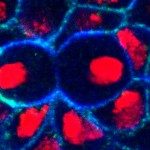Lien vers Pubmed [PMID] – 8050354
Development 1994 Jun;120(6):1433-41
Successive alternative cell fate choices in the imaginal disc epithelium lead to the differentiation of a relatively invariant pattern of multicellular adult sensory organs in Drosophila. We show here that the activity of Suppressor of Hairless is required for both the sensory organ precursor (SOP) versus epidermal cell fate decision, and for the trichogen (shaft) versus tormogen (socket) cell fate choice. Complete loss of Suppressor of Hairless function causes most proneural cluster cells to accumulate high levels of the achaete and Delta proteins and to adopt the SOP fate. Late or partial reduction in Suppressor of Hairless activity leads to the apparent transformation of the tormogen (socket) cell into a second trichogen (shaft) cell, producing a ‘double shaft’ phenotype. We find that overexpression of Suppressor of Hairless has the opposite phenotypic effects. SOP determination is prevented by an early excess of Suppressor of Hairless activity, while at a later stage, the trichogen (shaft) cell is transformed into a second tormogen (socket) cell, resulting in ‘double socket’ bristles. We conclude that, for two different cell fate decisions in adult sensory organ development, decreasing or increasing the level of Suppressor of Hairless function confers mutant phenotypes that closely resemble those associated with gain and loss of Hairless activity, respectively. These results, along with the intermediate SOP phenotype observed in Suppressor of Hairless; Hairless double mutant imaginal discs, suggest that the two genes act antagonistically to commit imaginal disc cells stably to alternative fates.

